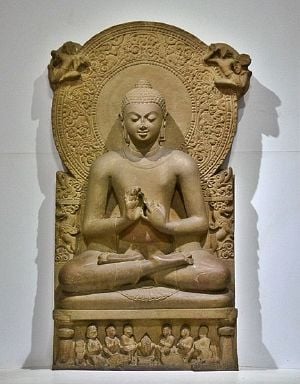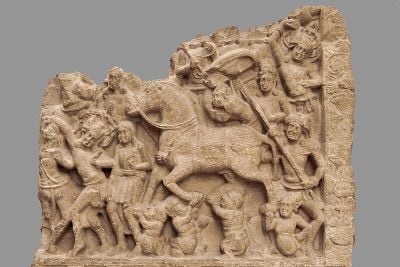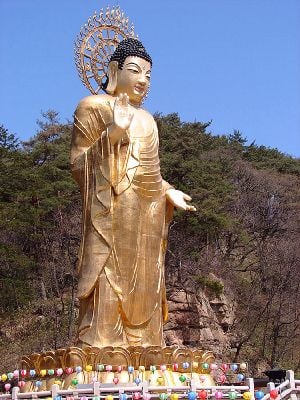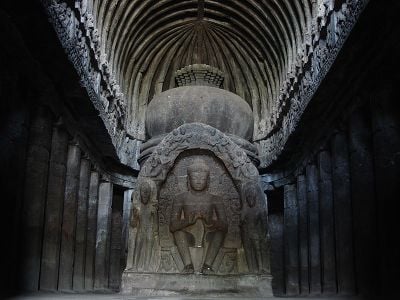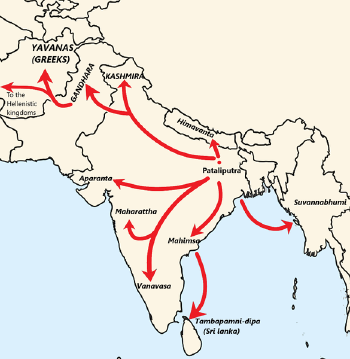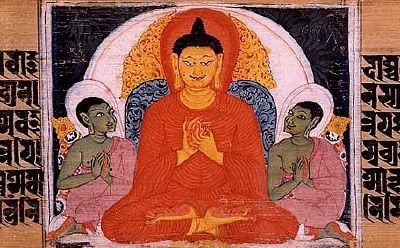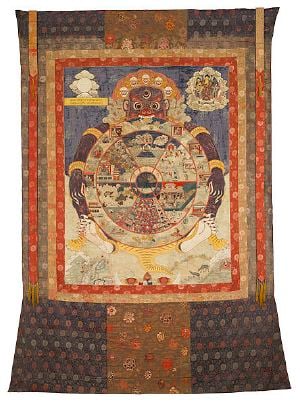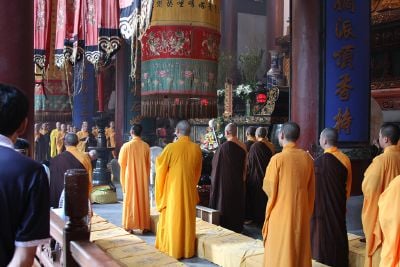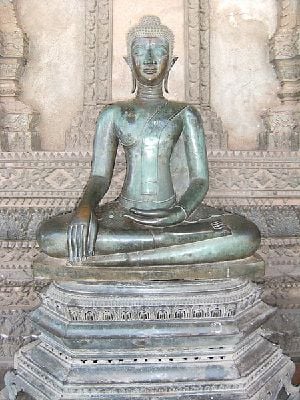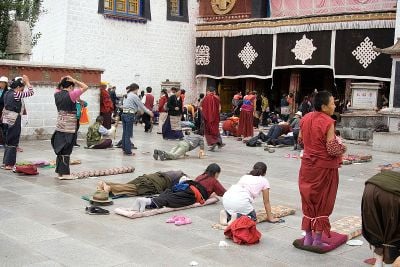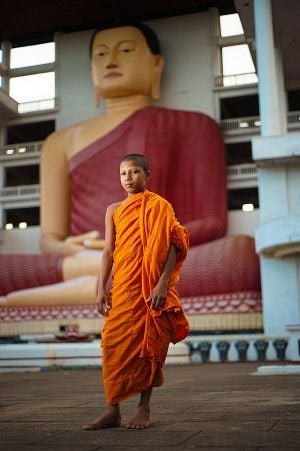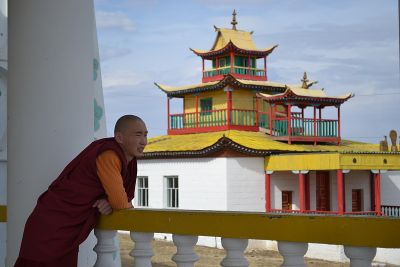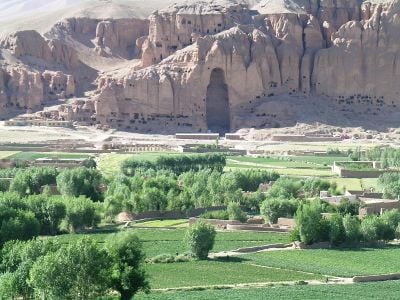|
History of Buddhism | |
|
Timeline of Buddhism | |
|
Foundations | |
|
Four Noble Truths | |
|
Key Concepts | |
|
Three marks of existence | |
|
Major Figures | |
|
Gautama Buddha | |
|
Practices and Attainment | |
|
Buddhahood · Bodhisattva | |
|
Regions | |
|
Southeast Asia · East Asia | |
|
Branches | |
|
Theravāda · Mahāyāna | |
|
Texts | |
|
Pali Canon · Mahayana Sutras | |
|
Comparative Studies | |
Buddhism is the world's fourth-largest religion with over 520 million followers, known as Buddhists. Buddhism encompasses a variety of traditions, beliefs, and spiritual practices largely based on original teachings attributed to Gautama Buddha and resulting interpreted philosophies. Buddhism originated in ancient India as a Sramana tradition sometime between the sixth and fourth centuries B.C.E., spreading through much of Asia, and at times reaching as far west as (modern day) Afghanistan. Two major extant branches of Buddhism are generally recognized by scholars: Theravada (Pali: "The School of the Elders") and Mahayana (Sanskrit: "The Great Vehicle"), although a great many other Buddhist paths are known and practiced, including the Vajrayana tradition of His Holiness, the Dalai Lama.
Most Buddhist traditions share the goal of overcoming dukkha (suffering) and Saṃsāra (cycle of death and rebirth), either by the attainment of Nirvana or through the path of Buddhahood. Buddhist schools vary in their interpretation of the path to liberation, the relative importance and canonicity assigned to the various Buddhist texts, and their specific teachings and practices. Widely observed practices include taking refuge in the Three Jewels, meditation, observance of moral precepts, and monasticism.
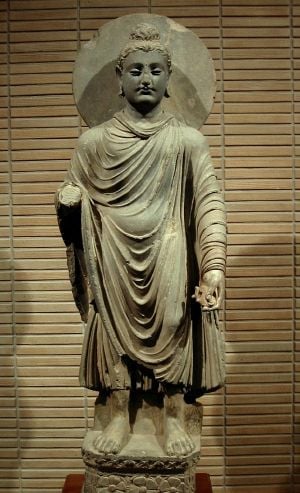
Belief in the "future Buddha," the Maitreya, a Bodhisattva who will eventually appear on earth, achieve complete enlightenment, and teach the pure dharma, is held by the vast majority of the world's Buddhists, regardless of their particular doctrinal orientations. The Maitreya will usher in a millennial era of peace, harmony, and prosperity.
Life of the Buddha
Buddhism is a world religion, originating in India, based on the life and teachings of the Buddha, born Siddhārtha Gautama, known also as the Tathāgata ("thus-gone") and Sakyamuni ("sage of the Sakyas"). Early texts cite his personal name as "Gautama" or "Gotama" (Pali) without any mention of the honorific "Siddhārtha" ("Achieved the Goal").
The evidence of the early texts suggests that he was born as Siddhārtha Gautama in Lumbini grew up in Kapilavasthu, a town in the plains region of the modern Nepal-India border, and spent his early life in what is now modern Bihar and Uttar Pradesh.[1]
According to the Buddhist sutras, Gautama was moved by the innate suffering of humanity and its endless repetition due to rebirth. His life quest was to to end human bondage to suffering. Early Buddhist canonical texts and early biographies of Gautama state that this quest brought Gautama first through study under Vedic teachers, including Alara Kalama (Sanskrit: Arada Kalama) and Uddaka Ramaputta (Sanskrit: Udraka Ramaputra), where he learned meditation and ancient philosophies, particularly the concept of "nothingness, emptiness" from the former, and "what is neither seen nor unseen" from the latter.[2][3]
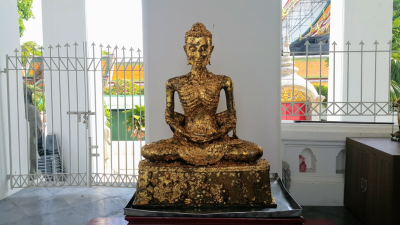
Gautama eventually found these teachings not sufficient to attain his goal, so he turned to the practice of asceticism. This too fell short of for him as a path, so he turned finally to the practice of dhyana, meditation. He famously sat in meditation under a Ficus religiosa, tree now called the Bodhi Tree, in the town of Bodh Gaya in the Gangetic plains region of South Asia. There he gained insight into the workings of karma and his former lives, and attained enlightenment. Subsequently he taught that the Middle Way is the path and spiritual practice that can end suffering (dukkha) from rebirths in Saṃsāra.[4]
Once fully enlightened as the Buddha, he attracted followers and founded a Sangha (monastic order). He taught this Dharma he discovered until he died at the age of 80 in Kushinagar, India.
Buddha's teachings were propagated by his followers leading to the development of over 18 sub-schools of Buddhist thought, each with its own Tripitaka based on different interpretations and authentic teachings of the Buddha. These evolved into many traditions. The best known and most widespread in the modern era are Theravada, Mahayana, and Vajrayana Buddhism.
Maitreya
Maitreya, the "future Buddha" in Buddhist eschatology, is a Bodhisattva who many Buddhists believe will eventually appear on earth, achieve complete enlightenment, and teach the pure dharma.
He will be the spiritual successor of the historic Śākyamuni Buddha. Unlike his antecedent, however, Maitreya is predicted to be a “world-ruler,” uniting those in an era of peace. Naturally this element of Buddhism influenced the arising and development of various apocalyptic and Utopian sub-groups, and in rare times even armed rebellions, throughout Asian history.
The Maitreya is interpreted as a figure of renewal, necessary once this age declines in faithfulness to the dharma, bringing knowledge and enlightenment.[5]
Prophecy of the coming Maitreya is found in the canonical literature of all Buddhist sects (Theravāda, Mahāyāna, and Vajrayāna) and is accepted by most Buddhists as a factual statement about a long-distant (or, in some cases, imminent) era of peace.
One of the earliest mentions of Maitreya can be found in the Sanskrit Maitreyavyākaraṇa (The Prophecy of Maitreya), which states that gods, men and other beings will worship Maitreya and:
will lose their doubts, and the torrents of their cravings will be cut off: free from all misery they will manage to cross the ocean of becoming; and, as a result of Maitreya's teachings, they will lead a holy life. No longer will they regard anything as their own, they will have no possession, no gold or silver, no home, no relatives! But they will lead the holy life of chastity under Maitreya's guidance. They will have torn the net of the passions, they will manage to enter into trances, and theirs will be an abundance of joy and happiness, for they will lead a holy life under Maitreya's guidance.[6]
In addition to his role as a spiritual leader, Maitreya was also styled after the chakravartin monarchs of Indian history and mythology ("Dharma kings" such as Asoka). As such, it was thought that he would emerge as a benevolent ruler over humanity, ushering in an era of peace and prosperity. Existing accounts suggest that the era of the "Future Buddha" would be characterized by the end of death, warfare, famine, and disease, "the fulfillment of Buddha's law," and "the establishment of universal peace and concord."[7]
History
The history of Buddhism may be divided into Early Buddhism (occasionally called pre-sectarian Buddhism), and Nikaya Buddhism or Sectarian Buddhism: the period of the early Buddhist schools including Theravada Buddhism, Early Mahayana Buddhism, later Mahayana Buddhism, and Vajrayana Buddhism. Buddhism also spread from its roots in India to much of Asia and beyond.
Historical roots
Buddhism religious thought arose during the Iron Age India, the middle of the first millennium B.C.E.[8] This was a period of great intellectual ferment and socio-cultural change.
During this time, new ideas developed both in the Vedic tradition in the form of the Upanishads, and outside of the Vedic tradition through the Śramaṇa movements. The Śramaṇa religions challenged and broke with the Brahmanic tradition on core elements. such as Atman (soul, self), Brahman, and the nature of afterlife. These new impulses rejected the authority of the Vedas and Upanishads.[9]
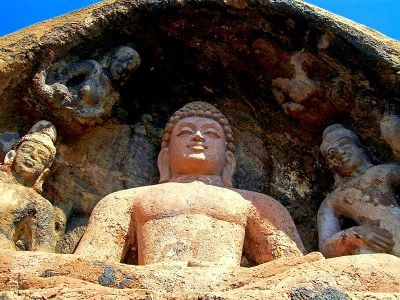
Pre-sectarian Buddhism
Pre-sectarian Buddhism references the earliest Buddhism, including the ideas and practices of Gautama Buddha himself. As the name suggests, this is the period prior to the development of different schools with their different positions.
Early Buddhist Texts include four principal Nikāyas: the Digha Nikaya, Majjhima Nikaya, Samyutta Nikaya, and Anguttara Nikaya (and their parallel Agamas). Also included is the main body of monastic rules, which survive in various versions of the patimokkha.[8][10] Due to edits and revisions over time, debate now persists over what constitutes the earliest layer of Buddhist teachings.
The prevalence of key basic teachings throughout early texts leads toward consensus that Gautama Buddha taught some clear version of the Four Noble Truths, the Noble Eightfold Path, Nirvana, the three marks of existence, the five aggregates, dependent origination, karma, and rebirth.[11]
Early Buddhist schools
For 400 years following the death of the Buddha, several new schools and movements arose. These include: Nikaya Buddhism, of which only Theravada remains today, as well as Mahayana and Vajrayana, which were based on new scriptures, and the revision of older techniques.
Historical writings report that the First Buddhist council was held soon after the Parinirvana (from Sanskrit: "highest extinguishment") of Gautama Buddha. Buddhism, like most or all ancient traditions at first was transmitted through oral tradition. The primary purpose of the assembly was to recite the teachings collectively to ensure against error in oral transmission. This tradition of monastic assembly recitations of the Buddha's teaching likely began during Buddha's lifetime. The First Council, that helped compose Buddhist scriptures, was an extension of this.[12]
The Second Buddhist council resulted in the first schism in the Sangha. After unsuccessfully trying to modify the Vinaya, a small group of "elderly members," or sthaviras, broke away from the majority Mahāsāṃghika during the Second Buddhist council, giving rise to the Sthavira Nikaya.[13] The Sthaviras gave rise to several schools, one of which was the Theravada school.
Following this and later schisms, each Saṅgha began to accumulate their own version of Tripiṭaka (Pali Canons, triple basket of texts). In their Tripiṭaka, each school included the Suttas of the Buddha, a Vinaya basket (disciplinary code), and added an Abhidharma basket which were texts on detailed scholastic classification, summary, and interpretation of the Suttas.[10] The doctrine details in the Abhidharmas of various Buddhist schools differ significantly. Most were composed beginning in the third century B.C.E. and continuing through the first millennium C.E.[14] Eighteen early Buddhist schools are known, each with its own Tripitaka, but only one collection from Sri Lanka has survived, in a nearly complete state, into the modern era.[15]
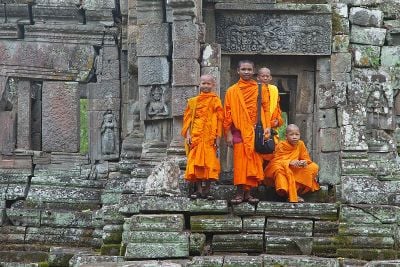
Early Mahayana Buddhism
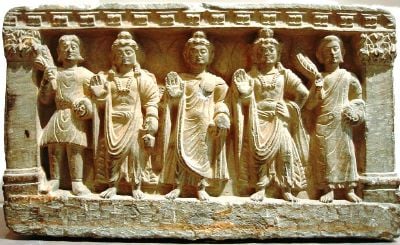
There is a debate among scholars as to whether Mahayana ever referred to a separate formal school or sect of Buddhism, or if it existed rather as a set of ideals, and later doctrines, for bodhisattvas.[16] Initially it was known as Bodhisattvayāna (the "Vehicle of the Bodhisattvas").[17]
Much of the extant evidence for Mahayana origins comes from early Chinese text translations. Mahayana teachings were propagated into China first by Lokakṣema, the first translator of Mahayana sutras into Chinese during the second century C.E.[18] Records written by Chinese monks visiting India indicate that both Mahayana and non-Mahayana monks could be found in the same monasteries, with the difference that Mahayana monks worshiped figures of Bodhisattvas, while non-Mahayana monks did not.[19]
Mahayana flourished in India from the time of Ashoka (304 B.C.E. - 232 B.C.E.) until the Guptas dynasty (fourth to sixth-century C.E.). Mahāyāna monastic foundations and centers of learning were established by Buddhist kings, and Hindu kings of the Gupta dynasty as evidenced by records left by three Chinese visitors to India.[20] The Gupta dynasty, for example, helped establish the famed Nālandā University in Bihar.[21] These monasteries and foundations helped develop Buddhist scholarship, as well as studies into non-Buddhist traditions, host visitors, and spread Buddhism into East and Central Asia.[22]
Late Mahayana Buddhism
During the Late Mahāyāna period, four major types of thought developed: Madhyamaka, Yogachara, Tathagatagarbha (Buddha-nature), and Buddhist logic, the last and most recent. In India, the two main philosophical schools of the Mahayana were Madhyamaka and the later Yogachara.[10]
Vajrayana (Esoteric Buddhism)
Vajrayāna Buddhism (also known as Tantric Buddhism, Tantrayāna, Esoteric Buddhism, and the Diamond Vehicle) refers to a family of Buddhist lineages found primarily in Tibet and Japan. These combine Mahayana ideals with a body of esoteric knowledge and tantric practice. In the Tibetan Buddhist tradition, it is claimed that the historical Shakyamuni Buddha taught tantra, but that since these are 'secret' teachings, confined to the guru/disciple relationship, they were generally written down long after the Buddha's other teachings, the Pali Canon and the Mahayana sutras.
The earliest texts appeared around the early fourth century. Nalanda University in northern India became a center for the development of Vajrayana theory, although it is likely that the university followed, rather than led, the early Tantric movement. India would continue as the source of leading-edge Vajrayana practices, producing many renowned Mahasiddha until the eleventh century.
Buddhism had mostly died out in India by the thirteenth century. Tantric aspects of Buddhism and Hinduism also experienced pressure from invading Muslim armies. By that time, the vast majority of the practices already had been taken to Tibet, where they were preserved.
In the second half of the twentieth century a sizable number of Tibetan exiles fled the anti-religious rule of the Communist Chinese in order to establish Tibetan Buddhist communities in India, most especially in Dharamsala where His Holiness established the Government of Tibet in exile. These refugees remain as the primary practitioners of Tantric Buddhism.
Spread of Buddhism
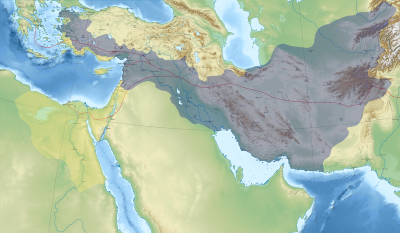
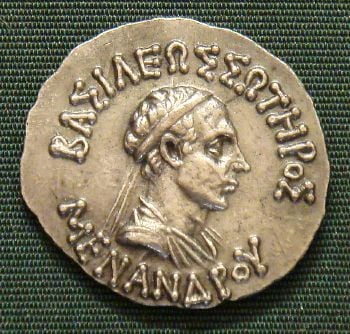
Buddhism is the first of the world religions to expand from its place of origin. It did so by two distinct routes.[23]
Buddhism likely spread only slowly in India until the time of the Mauryan emperor Ashoka, who came to support Buddhism publicly. The support of Aśoka and his descendants led to the construction of more stūpas (Buddhist religious memorials) and to the spread of Buddhism throughout the Maurya empire, including neighboring lands in Central Asia, as well as to the island of Sri Lanka. These two missions, in opposite directions, resulted ultimately to the spread of Buddhism into China, Korea, and Japan in the first case, and to the emergence of Sinhalese Theravāda Buddhism and its spread from Sri Lanka to much of Southeast Asia, including Myanmar, Malaysia, Indonesia, Thailand, Cambodia, and coastal Vietnam in the latter.[24]
This period marks the first known spread of Buddhism beyond India. According to the edicts of Aśoka, emissaries were sent to various countries west of India to spread Buddhism (Dharma), particularly in eastern provinces of the neighboring Seleucid Empire, and even farther to Hellenistic kingdoms of the Mediterranean.
Theravada Buddhism was carried eastwards into southeast Asia, in an upsurge of Indian trade from the first century C.E. as missionaries took advantage of the new opportunities for travel. The merchants and sailors were either Buddhist or Hindu. As a result, the kingdoms of southeast Asia, much influenced by the more advanced civilization of India, variously adopted Buddhist and Hindu religious practices. Which of the two prevailed was often the result of the preference of a ruling dynasty. The areas which eventually chose Buddhism are Burma, Thailand, Cambodia, and Laos.[23]
Mahayana Buddhism traveled by a land route. In the second century C.E. northern India and Afghanistan were ruled by the Kushan dynasty, one of whose kings, Kanishka, was a devotee of this form of Buddhism. His encouragement of it has special significance, since his kingdom occupied a central position on the Silk Road - at one of its busiest times, when its caravans effectively linked China with Rome.[23]
In central and west Asia, Buddhist influence grew through Greek-speaking Buddhist monarchs and ancient Asian trade routes. An example of this is evidenced in Chinese and Pali Buddhist records, such as Milindapanha and the Greco-Buddhist art of Gandhāra.[25]
The first known Mahāyāna scriptural texts were translations into Chinese by the Kushan monk Lokakṣema in Luoyang, between 178 and 189 C.E.[26] From China, Buddhism was introduced into its neighbors Korea (fourth century), Japan (sixth–seventh centuries), and Vietnam (c. first–second centuries).[27][28]
The Kushans (mid first–third century C.E.) came to control the Silk Road trade through Central and South Asia, which brought them to interact with ancient Buddhist monasteries and societies in these regions. They patronized Buddhist institutions, and Buddhist monastery influence, and in this way expanded to become a world religion.[29] Buddhism spread to Khotan and China, eventually to other parts of the far east.[30]
During the Chinese Tang dynasty (618–907), Chinese Esoteric Buddhism was introduced from India and Chan Buddhism (Zen) became a major religion.[31] Chan continued to grow in the Song dynasty (960–1279) and it was during this era that it strongly influenced Korean Buddhism and Japanese Buddhism. Pure Land Buddhism also became popular during this period and was often practiced together with Chan.
During the Indian period of Esoteric Buddhism (from the eighth century onward), Buddhism spread from India to Tibet and Mongolia. The esoteric form allowed both a secluded monastic community as well as the social rites and rituals important to maintain stability in society.[4]
During the Middle Ages, Buddhism slowly declined in India.[32] The Islamic conquest of the Iranian Plateau in the seventh-century, followed by the Muslim conquests of Afghanistan, and the later establishment of the Ghaznavid kingdom with Islam as the state religion in Central Asia between the tenth- and twelfth-century led to the decline and disappearance of Buddhism from most of these regions.
Beliefs
Four Noble Truths – Dukkha and its ending
The Four Truths express the basic orientation of Buddhism:
- Dukkha: or the noble truth of suffering
- Samudaya: or the noble truth of the origin of suffering
- Nirodha: or the noble truth of the cessation of suffering
- Marga: or the noble truth of the way leading to the cessation of suffering
These Four Truths can be understood as follows: We crave and cling to impermanent states and things, which is dukkha, "incapable of satisfying," and painful.[33] This keeps us caught in samsara, the endless cycle of repeated rebirth, dukkha, and dying again.[34] But there is a way to achieve liberation from this endless cycle and to attain the state of nirvana, namely following the Noble Eightfold Path.[35]
The truth of dukkha is the basic insight that life in this mundane world, with its clinging and craving to impermanent states and things is unsatisfactory. Dukkha can be translated as "incapable of satisfying," "the unsatisfactory nature and the general insecurity of all conditioned phenomena," or "painful."[33] Dukkha is most commonly translated as "suffering," but this is inaccurate, since it refers not to episodic suffering, but to the intrinsically unsatisfactory nature of temporary states and things, including pleasant but temporary experiences. We expect happiness from states and things which are impermanent, and therefore cannot attain real happiness.
In Buddhism, dukkha is one of the three marks of existence, along with impermanence and anattā (non-self). Buddhism, like other major Indian religions, asserts that everything is impermanent (anicca), but, unlike them, also asserts that there is no permanent self or soul in living beings (anattā).[12]
Dukkha arises when we experience craving (tanha) and cling to these changing phenomena. The clinging and craving produces karma, which ties us to samsara, the round of death and rebirth.[36]
Dukkha ceases, or can be confined,[37] when craving and clinging cease or are confined. This also means that no more karma is being produced, and rebirth ends:
The Third Noble Truth is nirvana. The Buddha tells us that an end to suffering is possible, and it is nirvana. Nirvana is a "blowing out," just as a candle flame is extinguished in the wind, from our lives in samsara. It connotes an end to rebirth.[35]
Cessation of dukkha is nirvana, "blowing out," and peace of mind.[36]
By following the Buddhist path to moksha, liberation, one starts to disengage from craving and clinging to impermanent states and things. Ultimately, this leads to freedom from the endless cycle of samsara:
The Buddhist message then ... is not simply a psychological message, i.e. that desire is the cause of suffering because unsatisfied desire produces frustration. It does contain such a message to be sure; but more importantly it is an eschatological message. Desire is the cause of suffering because desire is the cause of rebirth; and the extinction of desire leads to deliverance from suffering because it signals release from the Wheel of Rebirth.[38]
The cycle of rebirth
Saṃsāra
Saṃsāra means "wandering," with the connotation of cyclic, circuitous change. It refers to the theory of rebirth and the "cycle of life, death, and rebirth, without beginning or end."[39] This is a fundamental assumption of Buddhism, as with all major Indian religions:
Buddhism shares with Hinduism the doctrine of Samsara, whereby all beings pass through an unceasing cycle of birth, death and rebirth until they find a means of liberation from the cycle. However, Buddhism differs from Hinduism in rejecting the assertion that every human being possesses a changeless soul which constitutes his or her ultimate identity, and which transmigrates from one incarnation to the next.[40]
Samsara in Buddhism is considered to be dukkha, unsatisfactory and painful,[39] perpetuated by desire and avidya (ignorance), and the resulting karma.[41]
Samsara ends if a person attains nirvana, the "blowing out" of the desires and the gaining of true insight into impermanence and non-self reality.[36] Liberation from this cycle of existence, the attainment of nirvana, has been the foundation and the most important historical justification of Buddhism.[1]
Rebirth

Rebirth refers to a process whereby beings go through a succession of lifetimes as one of many possible forms of sentient life, each running from conception to death.[17] In Buddhist thought, this rebirth does not involve any soul, because of its doctrine of anattā (Sanskrit: anātman, no-self doctrine) which rejects the concepts of a permanent self or an unchanging, eternal soul, as it is called in Hinduism and Christianity.[42]
The Buddhist traditions disagree on what it is in a person that is reborn, as well as how quickly the rebirth occurs after each death.[43] Some Buddhist traditions assert that "no self" doctrine means that there is no perduring self, but there is avacya (inexpressible) self which migrates from one life to another.[44] The majority of Buddhist traditions, in contrast, assert that vijñāna (a person's consciousness) though evolving, exists as a continuum and is the mechanistic basis of what undergoes rebirth, rebecoming, and redeath.[34] The rebirth depends on the merit or demerit gained by one's karma, as well as that accrued on one's behalf by a family member.[44]
Each rebirth takes place within one of five realms according to Theravadins, or six according to other schools – heavenly, demi-gods, humans, animals, hungry ghosts, and hellish.[10][18]
In East Asian and Tibetan Buddhism, rebirth is not instantaneous, and there is an intermediate state (Tibetan "bardo") between one life and the next.[44] The orthodox Theravada position rejects the wait, and asserts that rebirth of a being is immediate.[44] However there are passages in the Samyutta Nikaya of the Pali Canon that seem to lend support to the idea that the Buddha taught about an intermediate stage between one life and the next.[18][45]
Karma
In Buddhism, karma (from Sanskrit: "action, work") drives saṃsāra – the endless cycle of suffering and rebirth for each being. Good, skillful deeds (Pāli: kusala) and bad, unskillful deeds (Pāli: akusala) produce "seeds" in the unconscious receptacle (ālaya) that mature later either in this life or in a subsequent rebirth.[46] The existence of karma is a core belief in Buddhism, as with all major Indian religions. Good or bad karma accumulates even if there is no physical action, and just having ill or good thoughts creates karmic seeds; thus, actions of body, speech, or mind all lead to karmic seeds.[46]
A central aspect of Buddhist theory of karma is that intent (cetanā) matters and is essential to bring about a consequence or phala "fruit" or vipāka "result." This emphasis on intent is also found in Hinduism, and marks a difference from the karma theory of Jainism, where karma accumulates with or without intent.[46]
In the Buddhist traditions, life aspects affected by the law of karma in past and current births of a being include the form of rebirth, realm of rebirth, social class, character, and major circumstances of a lifetime.[46][38] It operates like the laws of physics, without external intervention, on every being in all six realms of existence including human beings and gods.[46]
A notable aspect of the karma theory in Buddhism is merit transfer. A person accumulates merit not only through intentions and ethical living, but also is able to gain merit from others by exchanging goods and services, such as through dāna (charity to monks or nuns).[46] Further, a person can transfer one's own good karma to living family members and ancestors.[38]
Liberation
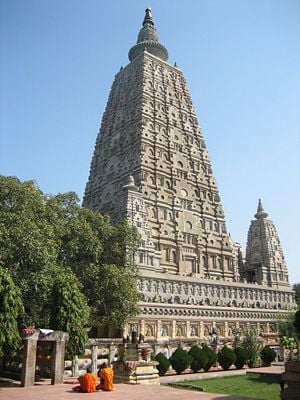
The attainment of nirvana (nibbāna), with which the cycle of rebirth ends, has been the primary and the soteriological goal of the Buddhist path for monastic life since the time of the Buddha.[44][47] The term "path" is usually taken to mean the Noble Eightfold Path, but other versions of "the path" can also be found in the Nikayas.
Nirvana literally means "blowing out, quenching, becoming extinguished."[48] In early Buddhist texts, it is the state of restraint and self-control that leads to the "blowing out" and the ending of the cycles of suffering associated with rebirths and redeaths.[49] The nirvana state has been described in Buddhist texts in a manner similar to other Indian religions, as the state of complete liberation, enlightenment, highest happiness, bliss, fearlessness, freedom, permanence, non-dependent origination, unfathomable, and indescribable.[47][46]
Many later Buddhist texts describe nirvana as a state of spiritual release marked by "emptiness, nothingness," and realization of non-self.[50] In some texts, the state is described in greater detail, such as passing through the gate of emptiness (sunyata) – realizing that there is no soul or self in any living being, then passing through the gate of signlessness (animitta) – realizing that nirvana cannot be perceived, and finally passing through the gate of wishlessness (apranihita) – realizing that nirvana is the state of not even wishing for nirvana.[44]
While Buddhism considers liberation from samsara as the ultimate spiritual goal, in traditional practice, the primary focus of the majority of lay Buddhists has been to seek and accumulate merit through good deeds, donations to monks, and various Buddhist rituals in order to gain better rebirths rather than nirvana.[51][40]
The path to liberation: Bhavana (practice, cultivation)
While the Noble Eightfold Path is best-known in the west, a wide variety of practices and stages have been used and described in the Buddhist traditions. Basic practices include sila (ethics), samadhi (concentration of the mind) and prajna (wisdom), as described in the Noble Eightfold Path. An important additional practice is a kind and compassionate attitude toward every living being and the world.
Devotion is also important in some Buddhist traditions, and in the Tibetan traditions visualizations of deities and mandalas are important. The value of textual study is regarded differently in the various Buddhist traditions. It is central to Theravada and highly important to Tibetan Buddhism, while the Zen tradition takes an ambiguous stance.
Refuge in the Three Jewels
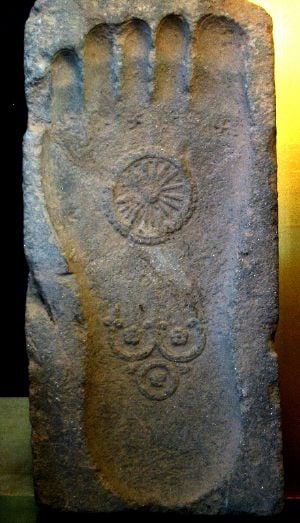
Traditionally, the first step in most Buddhist schools requires taking Three Refuges, also called the Three Jewels (Sanskrit: triratna, Pali: tiratana) as the foundation of one's religious practice.[46] Pali texts employ the Brahmanical motif of the triple refuge, found in the Rigveda 9.97.47, Rigveda 6.46.9 and Chandogya Upanishad 2.22.3–4. The Three Jewels are believed by Buddhists to be protective and a form of reverence.[46]
The Three Jewels are:
- The Gautama Buddha, the historical Buddha, the Blessed One, the Awakened with true knowledge
- The Dharma, the precepts, the practice, the Four Truths, the Eightfold Path
- The Sangha, order of monks, the community of Buddha's disciples
Reciting the Three Jewels (Refuges) is considered in Buddhism not as a place to hide, rather a thought that purifies, uplifts, and strengthens.[46]
The Buddhist path
Most Buddhist traditions share the goal of overcoming suffering and the cycle of death and rebirth, either by the attainment of Nirvana or through the path of Buddhahood.[1] Buddhist schools vary in their interpretation of the path to liberation, the relative importance and canonicity assigned to the various Buddhist texts, and their specific teachings and practices.[26]
Noble Eightfold Path

An important guiding principle of Buddhist practice is the Middle Way (madhyamapratipad). It was a part of Buddha's first sermon, where he presented the Noble Eightfold Path, or "Eightfold Path of the Noble Ones," that was a 'middle way' between the extremes of asceticism and hedonistic sense pleasures.[17] In Buddhism, the doctrine of "dependent arising" (conditioned arising, pratītyasamutpāda) to explain rebirth is viewed as the 'middle way' between the doctrines that a being has a "permanent soul" involved in rebirth (eternalism) and "death is final and there is no rebirth" (annihilationism).[44]
The Noble Eightfold Path has become an important description of the Buddhist path. It consists of a set of eight interconnected factors or conditions, that when developed together, lead to the cessation of dukkha. These eight factors, grouped together into three categories, are:[52]
- Wisdom (Sanskrit: prajñā, Pāli: paññā): Right View (or Right Understanding), Right Intention (or Right Thought)
- Ethical conduct (Sanskrit: śīla, Pāli: sīla): Right Speech, Right Action, Right Livelihood
- Mental discipline (Sanskrit and Pāli: samādhi): Right Effort, Right Mindfulness, and Right Concentration.
This Eightfold Path is the fourth of the Four Noble Truths, and asserts the path to the cessation of dukkha (suffering, pain, unsatisfactoriness).[1] The path teaches that the way of the enlightened ones stopped their craving, clinging and karmic accumulations, and thus ended their endless cycles of rebirth and suffering.[19]
Prajñā – Wisdom
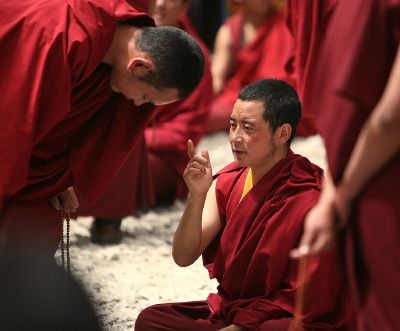
Prajñā (Sanskrit) or paññā (Pāli) is insight or knowledge of the true nature of existence. The Buddhist tradition regards ignorance (avidyā), a fundamental ignorance, misunderstanding or mis-perception of the nature of reality, as one of the basic causes of Dukkha and Samsara. By overcoming ignorance or misunderstanding one is enlightened and liberated. This overcoming includes awakening to impermanence and the non-self nature of reality, and this develops dispassion for the objects of clinging, and liberates a being from dukkha and Samsara.[53] Prajñā is important in all Buddhist traditions, and is the wisdom about the dharmas, functioning of karma and rebirths, realms of samsara, impermanence of everything, no-self in anyone or anything, and dependent origination.[18]
This subdivision of the Noble Eightfold Path concerned with wisdom consists of those elements that refer primarily to the mental or cognitive aspects of Buddhist praxis:
- Right understanding
Right understanding (samyag-dṛṣṭi · sammā-diṭṭhi), which can also be translated as "right view" or "right perspective," refers explicitly to the fact that the Buddhist practitioner must have accepted and internalized the moral metaphysics outlined in the Four Noble Truths. The direct connection between these two Buddhist dogmas is articulated in the Mahāsatipaṭṭhāna Sutta, a discourse attributed to the Buddha:
And what, O bhikkhus, is right understanding? To understand suffering, to understand the origination of suffering, to understand extinction of suffering, to understand the path leading to the extinction of suffering; this is called right understanding[54]
- Right thought
Right thought (samyak-saṃkalpa · sammā-saṅkappa), which can also be translated as "right intention," "right resolve," or "right aspiration," refers to the modification of one's worldview - specifically through the internalization of Buddhist attitudes. It refers to an engendering of good will, a renunciation of worldly things, and an accordingly greater devotion to spiritual matters. In the Magga-vibhanga Sutta, it is simply explained as follows:
And what, monks, is right resolve? Resolve for renunciation, resolve for non-ill will, resolve for harmlessness: This, monks, is called right resolve.[55]
Śīla – Buddhist ethics
The "ethical conduct" (Śīla) subdivision of the Noble Eightfold Path is constituted by those praxis elements that pertain to a Buddhist practitioner's relationship with other members of his or her society. They are structured around the Buddhist moral ideal of karuṇā, which is generally translated as "compassion."
- Right speech
Right speech (samyag-vāc · sammā-vācā), similar to the exhortation not to "bear false witness" refers to a Buddhist practitioner's proper use of language. In the Magga-vibhanga Sutta, this aspect of the Noble Eightfold Path is explained as follows:
And what, monks, is right speech? Abstaining from lying, abstaining from divisive speech, abstaining from harsh speech, abstaining from idle chatter: This, monks, is called right speech.[55]
- Right action
Right action (samyak-karmānta · sammā-kammanta), which can also be translated as "right conduct," refers to the practical ethics to be employed by Buddhist practitioner in his or her daily life. Describing this practice, the Magga-vibhanga Sutta states:
And what, monks, is right action? Abstaining from taking life, abstaining from stealing, abstaining from sexual intercourse: This, monks, is called right action.[55]
- Right livelihood
Right livelihood (samyag-ājīva · sammā-ājīva) is a precept that governs the appropriate occupations for Buddhist lay-people. It is based around the concept of ahiṁsā ("harmlessness" or "non-violence"), and thus states that Buddhist practitioners ought not to engage in trades or occupations that (either directly or indirectly) result in harm to other living beings. Such occupations include, but are not limited to, "trading in arms and lethal weapons, intoxicating drinks, poisons, killing animals, [and] cheating."[36] Likewise, "business in human beings"—such as slave trading and prostitution—is also forbidden,[56] as are several other dishonest means of gaining wealth, such as "Scheming, persuading, hinting, belittling, and pursuing gain with gain."[57]
- Precepts
Śīla appear as ethical precepts for both lay and ordained Buddhist devotees. It includes the Five Precepts for laypeople, Eight or Ten Precepts for monastic life, as well as rules of Dhamma (Vinaya or Patimokkha) adopted by a monastery.[12]
Buddhist scriptures explain the five precepts (Pali: pañcasīla; Sanskrit: pañcaśīla) as the minimal standard of Buddhist morality. It is the most important system of morality in Buddhism, together with the monastic rules. The five precepts apply to both male and female devotees, and these are:[12]
- Abstain from killing (Ahimsa);
- Abstain from stealing;
- Abstain from sensual (including sexual) misconduct;
- Abstain from lying;
- Abstain from intoxicants.
Undertaking and upholding the five precepts is based on the principle of non-harming (Pāli and Sanskrit: ahiṃsa).[17] The Pali Canon recommends one to compare oneself with others, and on the basis of that, not to hurt others.[58] Compassion and a belief in karmic retribution form the foundation of the precepts. Undertaking the five precepts is part of regular lay devotional practice, both at home and at the local temple. However, the extent to which people keep them differs per region and time.[58]
The five precepts are not commandments and transgressions do not invite religious sanctions; rather their power is based on the Buddhist belief in karmic consequences and their impact in the afterlife. Killing in Buddhist belief leads to rebirth in the hell realms, and for a longer time in more severe conditions if the murder victim was a monk. Adultery, similarly, invites a rebirth as prostitute or in hell, depending on whether the partner was unmarried or married. These moral precepts have been voluntarily self-enforced in lay Buddhist culture through the associated belief in karma and rebirth.[59] Within the Buddhist doctrine, the precepts are meant to develop mind and character to make progress on the path to enlightenment.
The monastic life in Buddhism has additional precepts as part of patimokkha, and unlike lay people, transgressions by monks do invite sanctions. Full expulsion from sangha follows any instance of killing, engaging in sexual intercourse, theft, or false claims about one's knowledge. Temporary expulsion follows a lesser offense. The sanctions vary per monastic fraternity (nikaya).[59] In addition to these precepts, Buddhist monasteries have hundreds of rules of conduct, which are a part of its patimokkha.
- Vinaya
Vinaya is the specific code of conduct for a sangha of monks or nuns. It includes the Patimokkha, a set of 227 offenses including 75 rules of decorum for monks, along with penalties for transgression, in the Theravadin tradition.[60] The precise content of the Vinaya Pitaka (scriptures on the Vinaya) differs in different schools and tradition, and different monasteries set their own standards on its implementation. Buddhist texts with vinaya rules for monasteries have been traced in all Buddhist traditions, with the oldest surviving being the ancient Chinese translations.[60]
Monastic communities in the Buddhist tradition cut normal social ties to family and community, and live as "islands unto themselves." Within a monastic fraternity, a sangha has its own rules. A monk abides by these institutionalized rules, and living life as the vinaya prescribes it is not merely a means, but very nearly the end in itself. Transgressions by a monk invite sanctions, which can include temporary or permanent expulsion.[60]
Mental discipline – Samadhi
Samadhi, the "mental discipline" subdivision of the Noble Eightfold Path is constituted by those elements pertaining to a Buddhist practitioner's vigilant efforts to perfect their minds through concerted meditation practice.
- Right effort
Right effort (samyag-vyāyāma · sammā-vāyāma), which can also be translated as "right endeavor," refers to the Buddhist aspirant's continuous effort to keep his or her mind free of "negative" thoughts that might impair his or her ability to realize the other elements of the Noble Eightfold Path. By making right effort, a Buddhist practitioner is considered to be engaging in a lifestyle that is wholesome in karmic terms, in terms of that effort's ultimate consequences to the practitioner.
- Right mindfulness
Right mindfulness (samyak-smṛti · sammā-sati), also translated as "right memory," is seen as a component of (and precursor to) the practice of Buddhist meditation. Roughly speaking, "mindfulness" refers to "self"-awareness, or, more specifically, the practice of being constantly alert to phenomena that affect the body and mind. The Buddha's explanation is as follows:
And what, monks, is right mindfulness? Herein, a monk dwells contemplating the body in the body, ardent, clearly comprehending and mindful, having put away covetousness and grief concerning the world. He dwells contemplating feelings in feelings... states of mind in states of mind... phenomena in phenomena, ardent, clearly comprehending and mindful, having put away covetousness and grief concerning the world.[61]
- Right concentration
Right concentration (samyak-samādhi · sammā-samādhi) (which is possible only in a mind properly condition through "right effort" and "right mindfulness") refers to the practice of Buddhist meditation, with the ultimate goal of consciousness expansion.
Right concentration is achieved through a series of eight steps, divided into two sets of four each, each step depending on mastery of the preceding level. The first set are called the four dhyana or jhanas; the second set, the four immaterial states (aruppa):
And what, monks, is right concentration? Herein, secluded from sense pleasures, secluded from unwholesome states, a monk enters and dwells in the first jhana, which is accompanied by initial and sustained application of mind and filled with rapture and happiness born of seclusion.
Then, with the subsiding of initial and sustained application of mind, by gaining inner confidence and mental unification, he enters and dwells in the second jhana, which is free from initial and sustained application but is filled with rapture and happiness born of concentration.
With the fading out of rapture, he dwells in equanimity, mindful and clearly comprehending; and he experiences in his own person that bliss of which the noble ones say: "Happily lives he who is equanimous and mindful" — thus he enters and dwells in the third jhana.
With the abandoning of pleasure and pain and with the previous disappearance of joy and grief, he enters and dwells in the fourth jhana, which has neither-pleasure-nor-pain and purity of mindfulness due to equanimity.
This, monks, is right concentration.[62]
Meditation and insight
A wide range of meditation practices has developed in the Buddhist traditions, but "meditation" primarily refers to the practice of dhyana (jhana). It is a practice in which the attention of the mind is first narrowed to the focus on one specific object, such as the breath, a concrete object, or a specific thought, mental image, or mantra. After this initial focusing of the mind, the focus is coupled to mindfulness, maintaining a calm mind while being aware of one's surroundings.
The practice of dhyana aids in maintaining a calm mind, and avoiding disturbance of this calm mind by mindfulness of disturbing thoughts and feelings.[34]
Visualizations: deities, mandalas
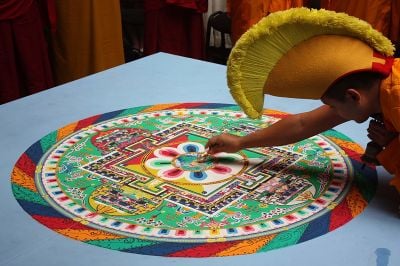
Idols of deities and icons historically have been a part of the practice of Buddhism. In the eleventh-century Sadanamala, a devotee visualizes and identifies himself or herself with the imagined deity as part of meditation.[40]
In Tibetan Buddhism tradition, mandala are mystical maps with cosmic symbolism. The mandalas are concentric geometric shapes symbolizing layers of the external world, gates, and sacred space. There are numerous deities, each with a mandala, and they are used during initiation ceremonies and meditation. The meditation deity is in the center, sometimes surrounded by protective gods and goddesses.[40]
Devotion
Bhakti (Bhatti in Pali), or devotion is an important part of the practice of most Buddhists. Devotional practices include ritual prayer, prostration, offerings, pilgrimage, and chanting.[40] It has been a common practice in Theravada Buddhism from the earliest days, with offerings and group prayers made to deities and particularly images of Buddha.[63]
In other schools of Buddhism, devotion takes different forms. For example, in Pure Land Buddhism, devotion to the Buddha Amitabha is the main practice, while in Nichiren Buddhism, devotion to the Lotus Sutra is the main practice.
Guru devotion is a central practice of Tibetan Buddhism. The guru is considered essential and to the Buddhist devotee, the guru is the "enlightened teacher and ritual master" in Vajrayana spiritual pursuits.[64]
Buddhist texts
Buddhism originally was transmitted orally. The first Buddhist canonical texts were likely written in Sri Lanka, approximately 400 years after the Buddha's death.[65] These comprised parts of the Tripitakas, thereafter many versions appeared claiming to be the words of the Buddha.
Scholarly texts of commentary with named authors appeared in India approximately during the second century C.E. These texts were written in Pali, Sanskrit, and sometimes regional languages. They were inscribed on such media as palm-leaf manuscripts, birch bark, painted scrolls, carved into temple walls, and later on paper.[65]
Each Buddhist sect has its own collection of texts, much of which are translations from ancient Pali and Sanskrit texts from India. The canonical corpus is vast. It includes the ancient Sutras organized into Nikayas, that are part of the three baskets of texts called the Tripitakas.[65]
Early Buddhist Texts
The first four Pali Nikayas, and the corresponding Chinese Āgamas, are generally considered to be among the earliest Buddhist texts.[1] Additionally there exist fragmentary collections in languages such as Sanskrit, Khotanese, Tibetan, and Gāndhārī.
Pāli Tipitaka
The Pāli Tipitaka (Sanskrit: Tripiṭaka, three pitakas), which means "three baskets," refers to the Vinaya Pitaka, the Sutta Pitaka, and the Abhidhamma Pitaka, the oldest known canonical works of Buddhism. The Vinaya Pitaka contains disciplinary rules for the Buddhist monasteries. The Sutta Pitaka contains words attributed to the Buddha. The Abhidhamma Pitaka contain expositions and commentaries on the Sutta. These vary significantly among Buddhist schools.
The Pali Canon of the Theravada School, Pāli Tipitaka, is the only surviving, Indic language, complete collection of Buddhist texts. Sutras, Vinayas, and Abhidharma works, which are part of the Chinese Buddhist Canon, survive in Chinese translation.
Abhidharma and the Commentaries
A distinctive feature of many Tripitaka collections is the inclusion of a genre called Abhidharma, which dates from the third century B.C.E. and later. The genre began as explanations and elaborations of the teachings in the sutras, but evolved into an independent system of doctrinal exposition.[18]
Over time, the various Abhidharma traditions developed various disagreements which each other on points of doctrine, which were discussed in the different Abhidharma texts of these schools. The major Abhidharma collections which modern scholars have the most information about are those of the Theravāda and Sarvāstivāda schools.[1]
In Sri Lanka and South India, the Theravāda Abhidhamma system was the most influential. In addition to the Abhidharma project, some of the schools also began accumulating a literary tradition of scriptural commentary on their respective Tripitakas. These commentaries were particularly important in the Theravada school, and the Pali commentaries (Aṭṭhakathā) remain influential today. Both Abhidhamma and the Pali Commentaries influenced the Visuddhimagga, an important fifth-century text by the Theravada scholar Buddhaghosa, who also translated and compiled many of the Aṭṭhakathās from older Sinhalese sources.[1]
The Sarvāstivāda school was one of the most influential Abhidharma traditions in North India. The magnum opus of this tradition was the massive Abhidharma commentary called the Mahāvibhaṣa ('Great Commentary'), compiled at a great synod in Kashmir during the reign of Kanishka II (c. 158–176).[66] The Abhidharmakosha of Vasubandhu is another very influential Abhidharma work from the northern tradition, which continues to be studied in East Asian Buddhism and in Indo-Tibetan Buddhism.
Mahayana sutras
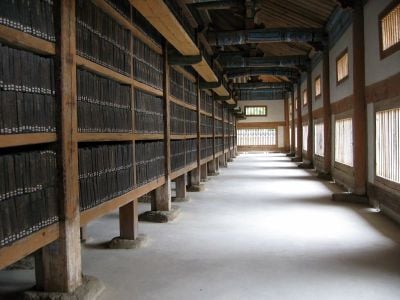
The Mahayana sutras are a very broad genre of Buddhist scriptures that the Mahayana Buddhist tradition holds are original teachings of the Buddha. The Mahayana sutras often claim to articulate the Buddha's deeper, more advanced doctrines, reserved for those who follow the bodhisattva path. That path is explained as being built upon the motivation to liberate all living beings from unhappiness. Hence the name Mahāyāna (literally the Great Vehicle). The Theravada school does not treat the Mahayana Sutras as authoritative or authentic teachings of the Buddha.[67]
Generally, scholars conclude that the Mahayana scriptures were composed from the first and fifth centuries C.E.[18]
Śālistamba Sutra
Many ancient Indian texts have not survived into the modern era, creating a challenge in establishing the historic commonalities between Theravada and Mahayana. The texts preserved in the Tibetan Buddhist monasteries, with parallel Chinese translations, have provided a breakthrough. Among these is the Mahayana text Śālistamba Sutra which no longer exists in a Sanskrit version, but does in Tibetan and Chinese versions.
The Śālistamba Sutra was cited by Mahayana scholars such as the eighth-century Yasomitra to be authoritative.[5] This Mahayana text contains numerous sections which are remarkably the same as the Theravada Pali Canon and Nikaya Buddhism. This suggests that Buddhist literature of different traditions shared a common core of Buddhist texts in the early centuries of its history, until Mahayana literature diverged after the first century C.E.[67]
Schools and traditions
Buddhists generally classify themselves as either Theravada or Mahayana.[17] An alternative scheme divides Buddhism into the following three traditions or geographical or cultural areas: Theravada, East Asian Buddhism, and Tibetan Buddhism.
Not all traditions of Buddhism share the same philosophical outlook, or treat the same concepts as central.
- Both Theravada and Mahayana traditions accept the Buddha as the founder; Theravada considers him unique, but Mahayana considers him one of many Buddhas
- Both accept the Middle Way, dependent origination, the Four Noble Truths, the Noble Eightfold Path and the three marks of existence
- Nirvana is attainable by the monks in Theravada tradition, while Mahayana considers it broadly attainable; Arhat state is aimed for in the Theravada, while Buddhahood is aimed for in the Mahayana tradition
- Religious practice consists of meditation for monks and prayer for laypersons in Theravada, while Mahayana includes prayer, chanting, and meditation for both
- Theravada has been a more rationalist, historical form of Buddhism; while Mahayana has included more rituals, mysticism, and worldly flexibility in its scope.[68]
Theravada school
Theravāda (Pāli: "School of the Elders")] is the most commonly accepted name of Buddhism's oldest extant school, with an uninterrupted lineage of thought and practice extending over two thousand years. The school's adherents, termed Theravādins, have preserved their version of the Gautama Buddha's teaching in the Pāli Canon. In contrast to Mahāyāna and Vajrayāna, Theravāda tends to be conservative in matters of doctrine and monastic discipline.
The Theravada tradition traces its roots to the words of the Buddha preserved in the Pali Canon, and considers itself to be the orthodox form of Buddhism: "Theravadins claim that they alone represent true Buddhist orthodoxy, and that other sects are heretics."[69]
The most distinctive characteristic of Theravadin practice is the central importance of monastic life, such that ultimate religious attainment is often seen as exclusive domain of the bhikkhus (religious renunciants). The tradition's ideal, the arhat, represents a monk/nun who has successfully followed the historical Buddha's teachings, which allow them to break the chains of dependent arising and escape from the cycle of samsara. This particularized nature of salvation led some to criticize the school as a "Lesser Vehicle" (Hinayana), in contrasted to Mahāyāna, which means the "great vehicle."
Theravāda is primarily practiced today in Sri Lanka, Myanmar, Laos, Thailand, Cambodia as well as small portions of China, Vietnam, Malaysia, and Bangladesh. It has a growing presence in the west.
Mahayana traditions
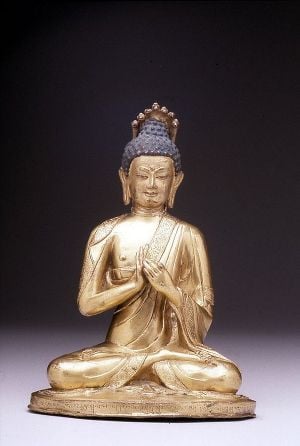
Mahayana schools consider the Mahayana Sutras as authoritative scriptures and accurate rendering of Buddha's words.[67] These traditions have been the more liberal form of Buddhism allowing different and new interpretations that emerged over time.
Mahayana Buddhism is based principally upon the path of a Bodhisattva, one who is on the path to buddhahood. The term Mahāyāna was originally a synonym for Bodhisattvayāna or "Bodhisattva Vehicle."[16]
In the earliest texts of Mahayana Buddhism, the path of a bodhisattva was to awaken the bodhicitta. Between the first and third centuries C.E., this tradition introduced the Ten Bhumi doctrine, which means ten levels or stages of awakening.[70] This development was followed by the acceptance that it is impossible to achieve Buddhahood in one (current) lifetime, and the best goal is not nirvana for oneself, but Buddhahood after climbing through the ten levels during multiple rebirths.[16] Mahayana scholars then outlined an elaborate path, for monks and laypeople, and the path includes the vow to help teach Buddhist knowledge to other beings, so as to help them cross samsara and liberate themselves, once one reaches the Buddhahood in a future rebirth.[16] One part of this path are the Pāramitā (perfections, to cross over), derived from the Jatakas tales of Buddha's numerous rebirths.[70]
Native Mahayana Buddhism is practiced today in China, Japan, Korea, Singapore, parts of Russia, and most of Vietnam (also commonly referred to as "Eastern Buddhism"). The Buddhism practiced in Tibet, the Himalayan regions, and Mongolia is also Mahayana in origin, but is known as Vajrayana.
There are a variety of strands in Eastern Buddhism. In most of this area however, they are fused into a single unified form of Buddhism. In Japan in particular they form separate denominations with the five major ones being: Nichiren, peculiar to Japan; Pure Land; Shingon, a form of Vajrayana; Tendai, and Zen. In Korea, nearly all Buddhists belong to the Chogye school, which is officially Son (Zen), but with substantial elements from other traditions.[18]
Vajrayana
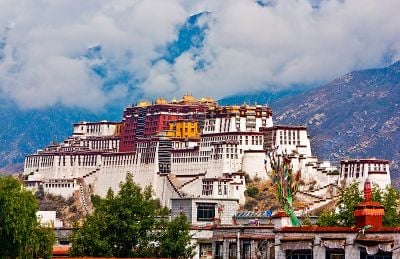
Vajrayana Buddhism (also known as Tantric Buddhism, Tantrayāna, Esoteric Buddhism, and the Diamond Vehicle) refers to a family of Buddhist lineages found primarily in Tibet and Japan, which combine Mahayana ideals with a body of esoteric knowledge and tantric practice.
Vajrayāna subscribes to the literature known as the Buddhist Tantras. Vajrayāna Buddhists do not claim that Theravada or Mahayana practices are invalid; on the contrary, the teachings from those traditions are said to lay an essential foundational understanding on which the Vajrayāna practices may be built. The goal and philosophy of the Vajrayāna remains Mahāyānist, but its methods are seen by its followers as far more powerful, so as to lead to Buddhahood in just one lifetime.[46]
Vajrayāna includes practices that make use of mantras, dharanis, mudras, mandalas, and the visualization of deities and Buddhas.
Tibetan Buddhism preserves the Vajrayana teachings of eighth-century India, and so is part of the Tantric Vajrayana tradition. Tantric Buddhism is largely concerned with ritual and meditative practices. A central feature of Buddhist Tantra is deity yoga which includes visualization and identification with an enlightened yidam or meditation deity and its associated mandala. Another element of Tantra is the need for ritual initiation or empowerment (abhiṣeka) by a Guru or Lama.[19]
Zen
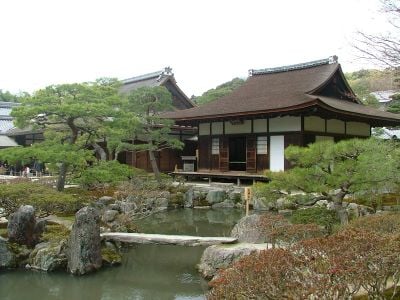
Zen Buddhism (禅), pronounced Chán in Chinese, Seon in Korean, Zen in Japanese, and Thien in Vietnam. The name is derived from the Sanskrit term dhyāna, meaning "meditation"). According to tradition, Zen originated in India as a non-verbal doctrine communicated directly by the Buddha to his followers. It was later taken to China by the monk Bodhidharma, where it was subsequently transmitted to other parts of Asia.
Zen Buddhism lays special emphasis on meditation, in particular zazen (literally "seated meditation"), and direct discovery of the Buddha-nature.[72] It is divided into two main schools: Rinzai (臨済宗) and Sōtō (曹洞宗). In the Japanese Rinzai school, zazen is usually associated with the study of koans (公案, meditative riddles or puzzles) as a device for spiritual break-through. The Sōtō School of Japan, on the other hand, only rarely incorporates koans into zazen, preferring an approach where the mind has no object at all, known as shikantaza or "just sitting."
Buddhism in the modern era
Buddhism has spread across the world and Buddhist texts are increasingly translated into local languages. While Buddhism in the West is often seen as exotic and progressive, in the East it is regarded as familiar and traditional. In countries such as Cambodia and Bhutan, it is recognized as the state religion and receives government support.
Like other religions, some of Buddhism's basic premises have been challenged by the findings of modern science. One response has come to be called Buddhist modernism or Neo-Buddhism. Buddhist modernist figures such as the American convert Henry Olcott and Anagarika Dharmapala reinterpreted and promoted Buddhism as a scientific and rational religion which they saw as compatible with modern science.[10]
East Asian Buddhism meanwhile suffered under various wars which ravaged China during the modern era, such as the Taiping rebellion and World War II, which also affected Korean Buddhism. During the Republican period (1912–1949), a new movement called Humanistic Buddhism was developed by figures such as Taixu, and though Buddhist institutions were destroyed during the Cultural Revolution (1966–1976), since then there has been a revival of the religion in China.[10]
In Central Asia meanwhile, the arrival of Communist repression to Tibet (1966–1980) and Mongolia (between 1924–1990) had a strong negative impact on Buddhist institutions.[10]
In certain regions such as Afghanistan and Pakistan, militants have targeted historic Buddhist monuments with violence and destruction.[73]

Buddhism in the West

While there were some early encounters of Western travelers or missionaries such as St. Francis Xavier and Ippolito Desideri with Buddhist cultures, it was not until the nineteenth century that Buddhism began to be studied by Western scholars. During the nineteenth century Asian Buddhist immigrants (mainly from China and Japan) began to arrive in Western countries such as the United States and Canada, bringing with them their Buddhist religion. This period also saw the first Westerners, such as Helena Blavatsky and Henry Steel Olcott, formally convert to Buddhism. In 1881, Thomas Rhys Davids founded the Pali Text Society – an influential Western resource of Buddhist literature in the Pali language and one of the earliest publisher of a journal on Buddhist studies. An important event in the introduction of Buddhism to the West was the 1893 World Parliament of Religions held in Chicago, which for the first time saw well-publicized speeches by major Buddhist leaders alongside other religious leaders.
The twentieth century saw a prolific growth of new Buddhist institutions in Western countries, including the Buddhist Society, London (1924), Das Buddhistische Haus (1924), and Datsan Gunzechoinei in Saint Petersburg. The publication and translations of Buddhist literature in Western languages thereafter accelerated. After World War II, further immigration from Asia as well a renewed interest in Buddhism among the 1960s counterculture led to further growth in Buddhist institutions.[74]
While Buddhist institutions have grown, some of the central premises of Buddhism such as the cycles of rebirth and Four Noble Truths have been problematic in the West.[75] In contrast, for "most ordinary [Asian] Buddhists, today as well as in the past, their basic moral orientation is governed by belief in karma and rebirth."[76] Most Asian Buddhist laypersons have historically pursued Buddhist rituals and practices seeking better rebirth,[40] not nirvana or freedom from rebirth.[53]
Neo-Buddhism movements
A number of modern movements in Buddhism emerged during the second half of the twentieth century. These modern Buddhist movements include Secular Buddhism in many countries, Won Buddhism in Korea, the Dhammakaya movement in Thailand, and several Japanese organizations, such as Shinnyo-en, Risshō Kōsei Kai, and Soka Gakkai.
Some of these movements brought internal disputes and strife within regional Buddhist communities. For example, the Dhammakaya movement in Thailand teaches a "true self" doctrine, which traditional Theravada monks consider as heretically denying the fundamental anatta (not-self) doctrine of Buddhism.[26][77]
In India, B.R. Ambedkar launched the Navayana tradition – literally, "new vehicle." Ambedkar's Buddhism rejects the foundational doctrines and historic practices of traditional Theravada and Mahayana traditions, such as monk lifestyle after renunciation, karma, rebirth, samsara, meditation, nirvana, Four Noble Truths, and others.[14] Ambedkar considered these as superstitions and re-interpreted the original Buddha as someone who taught about class struggle and social equality.[14] He urged low caste Indian Dalits to convert to his Marxism-inspired reinterpretation.[78]
Review
Though the classical, chronological structure of this article brings commentary to recent, in many ways peripheral expressions or permutations tracing themselves faintly through Buddhist, or Buddhist related threads, readers properly should conclude this level of research by reverting back to reflection and consideration of the noble born Siddhartha Gautama, the awakened one, a single soul who fundamentally altered the path of human history, pioneering the way for all beings to rise out of the deep sleep of ignorance.
Notes
- ↑ 1.0 1.1 1.2 1.3 1.4 1.5 1.6 Rupert Gethin, The Foundations of Buddhism (Oxford University Press, 1998, ISBN 978-0192892232).
- ↑ Alexander Wynne, The Origin of Buddhist Meditation (Routledge, 2007, ISBN 978-0415423878).
- ↑ Hajime Nakamura, Gotama Buddha: A Biography Based on the Most Reliable Texts (Kosei Publishing Company, 2001, ISBN 4333018935).
- ↑ 4.0 4.1 Johannes Bronkhorst, Buddhism in the Shadow of Brahmanism (Brill, 2011, ISBN 9004201408).
- ↑ 5.0 5.1 Alan Sponberg and Helen Hardacre (eds.), Maitreya, the Future Buddha (Cambridge University Press, 1988, ISBN 0521343445).
- ↑ Edward Conze (trans.), Buddhist Scriptures (Penguin Books, 1959, ISBN 9780140440881).
- ↑ Joseph M. Kitagawa, "The Many Faces of Maitreya: A Historian of Religions' Reflections" in Alan Sponberg and Helen Hardacre (eds.), Maitreya: The Future Buddha (Cambridge University Press, 1988, ISBN 0521343445).
- ↑ 8.0 8.1 Rupert Gethin, Sayings of the Buddha: New Translations from the Pali Nikayas (Oxford University Press, 2008, ISBN 019283925X).
- ↑ Mark Siderits, Buddhism as Philosophy: An Introduction (Hackett Publishing Company, Inc., 2007, ISBN 0872208737).
- ↑ 10.0 10.1 10.2 10.3 10.4 10.5 10.6 Peter Harvey, An Introduction to Buddhism: Teachings, History and Practices (Cambridge University Press, 2012, ISBN 0521676746).
- ↑ Donald W. Mitchell and Sarah H. Jacoby, Buddhism: Introducing the Buddhist Experience (Oxford University Press, 2013, ISBN 0199861870).
- ↑ 12.0 12.1 12.2 12.3 Paul Williams, Buddhism (Critical Concepts in Religious Studies) (Routledge, 2006, ISBN 0415332265).
- ↑ Andrew Skilton, A Concise History of Buddhism (Windhorse Publications, 2004, ISBN 0904766926).
- ↑ 14.0 14.1 14.2 Damien Keown and Charles S. Prebish (eds.), Encyclopedia of Buddhism (Routledge, 2004, ISBN 0415556244).
- ↑ Stephen C. Berkwitz et al. (eds.), Buddhist Manuscript Cultures: Knowledge, Ritual, and Art (Routledge, 2009, ISBN 9780415776165).
- ↑ 16.0 16.1 16.2 16.3 Jan Nattier, A Few Good Men: The Bodhisattva Path according to The Inquiry of Ugra (Ugraparipṛcchā) (University of Hawaii Press, 2005, ISBN 0824830032).
- ↑ 17.0 17.1 17.2 17.3 17.4 Damien Keown, Buddhism: A Very Short Introduction (Oxford University Press, 2013, ISBN 9780199663835).
- ↑ 18.0 18.1 18.2 18.3 18.4 18.5 18.6 Robert E. Buswell (ed.), Encyclopedia of Buddhism (Macmillan Library Reference, 2003, ISBN 0028657187).
- ↑ 19.0 19.1 19.2 Paul Williams, Buddhist Thought: A Complete Introduction to the Indian Tradition (Routledge, 2000, ISBN 0415207010).
- ↑ Hartmut Scharfe, Education in Ancient India (Brill, 2002, ISBN 9004125566).
- ↑ Le Huu Phuoc, Buddhist Architecture (Grafikol, 2010, ISBN 0984404309).
- ↑ Charles F.W. Higham, Encyclopedia of Ancient Asian Civilizations (Facts on File, 2004, ISBN 0816046409).
- ↑ 23.0 23.1 23.2 Buddhism in East Asia History of Buddhism. Retrieved December 21, 2020.
- ↑ John Guy, Lost Kingdoms: Hindu-Buddhist Sculpture of Early Southeast Asia (Metropolitan Museum of Art, 2014, ISBN 030020437X).
- ↑ Jason Neelis, Early Buddhist Transmission and Trade Networks: Mobility and Exchange Within and Beyond the Northwestern Borderlands of South Asia (Brill, 2010, ISBN 9004181598).
- ↑ 26.0 26.1 26.2 Paul Williams, Mahayana Buddhism: The Doctrinal Foundations (Routledge, 2008, ISBN 9780415356534).
- ↑ William Theodore de Bary, Donald Keene, George Tanabe, and Paul Varley (eds.) Sources of Japanese Tradition (New York: Columbia University Press, 2002, ISBN 9780231121392).
- ↑ Nguyen Tai Thu, The History of Buddhism in Vietnam (Council for Research in Values & Philosophy, 2009, ISBN 1565180984).
- ↑ Xinru Liu, The Silk Road in World History (Oxford University Press, 2010, ISBN 0195338103).
- ↑ Ann Heirman and Stephan Peter Bumbacher (eds.), The Spread of Buddhism (Brill, 2012, ISBN 9004226753).
- ↑ John R. McRae, Seeing Through Zen (University of California Press, 2004, ISBN 0520237986).
- ↑ Andrew Powell, Living Buddhism (Harmony, 1989, ISBN 0517572664).
- ↑ 33.0 33.1 Nyantiloka Thera, Buddhist Dictionary: A Manual of Buddhist Terms and Doctrines (Nyanatiloka, 1998, ISBN 9552400198).
- ↑ 34.0 34.1 34.2 Paul Williams, Buddhist Thought (Routledge, 2013, ISBN 0415571790).
- ↑ 35.0 35.1 Graham Harvey, Religions in Focus (Routledge, 2014, ISBN 184553218X).
- ↑ 36.0 36.1 36.2 36.3 Walpola Rahula, What the Buddha Taught (Grove Press, 1974, ISBN 0802130313).
- ↑ David Brazier, The Feeling Buddha: A Buddhist Psychology of Character, Adversity and Passion (Fromm International, 1998, ISBN 0880641983).
- ↑ 38.0 38.1 38.2 Melford E. Spiro, Buddhism and Society (University of California Press, 1982, ISBN 0520046722).
- ↑ 39.0 39.1 Jeff Wilson, Saṃsāra and Rebirth Oxford Bibliographies: Buddhism, September 2010. Retrieved January 25, 2022.
- ↑ 40.0 40.1 40.2 40.3 40.4 40.5 Kevin Trainor, Buddhism: The Illustrated Guide (Oxford University Press, 2004, ISBN 0195173988).
- ↑ Norman C. McClelland, Encyclopedia of Reincarnation and Karma (McFarland & Company, 2010, ISBN 0786448512).
- ↑ Oliver Leaman, Eastern Philosophy: Key Readings (Routledge, 2000, ISBN 0415173582).
- ↑ Ronald W. Neufeldt (ed.), Karma and Rebirth: Post Classical Developments (SUNY Press, 1986, ISBN 0873959906).
- ↑ 44.0 44.1 44.2 44.3 44.4 44.5 44.6 Robert E. Buswell and Donald S. Lopez, The Princeton Dictionary of Buddhism (Princeton University Press, 2013, ISBN 0691157863).
- ↑ Bhikkhu Bodhi (trans.), The Connected Discourses of the Buddha: A Translation of the Samyutta Nikaya (Wisdom Publications, 2003, ISBN 9780861713318).
- ↑ 46.00 46.01 46.02 46.03 46.04 46.05 46.06 46.07 46.08 46.09 46.10 Peter Harvey, The Selfless Mind (Routledge, 1995, ISBN 0700703381).
- ↑ 47.0 47.1 Steven Collins, Nirvana and Other Buddhist Felicities (Cambridge University Press, 2006, ISBN 0521578426).
- ↑ Steven Collins, Nirvana: Concept, Imagery, Narrative (Cambridge University Press, 2010, ISBN 0521708346).
- ↑ Tilmann Vetter, The Ideas and Meditative Practices of Early Buddhism (Brill Academic Pub., 1988, ISBN 9004089594).
- ↑ Steven Collins, Selfless Persons: Imagery and Thought in Theravada Buddhism (Cambridge University Press, 1982, ISBN 978-0521240819).
- ↑ Michael D. Coogan (ed.), The Illustrated Guide to World Religions (Oxford University Press, 2003, ISBN 019521997X).
- ↑ Bhikkhu Bodhi, Chapter VIII: The Development of Wisdom The Noble Eightfold Path: The Way to the End of Suffering. Access to Insight (BCBS Edition), November 30, 2013. Retrieved January 25, 2022.
- ↑ 53.0 53.1 Merv Fowler, Buddhism: Beliefs and Practices (Sussex Academic Press, 1999, ISBN 1898723664).
- ↑ Rewata Dhamma, The First Discourse of the Buddha (Somerville, MA: Wisdom Publications, 1997).
- ↑ 55.0 55.1 55.2 An Analysis of the Path Magga-Vibhaṅga Sutta (SN 45:8). Retrieved January 25, 2022.
- ↑ Business (Wrong Livelihood) Vaṇijjā Sutta (AN 5:177) Retrieved January 25, 2022.
- ↑ The Great Forty Mahā Cattārīsaka Sutta (MN 117) Retrieved January 25, 2022.
- ↑ 58.0 58.1 Peter Harvey, An Introduction to Buddhist Ethics: Foundations, Values and Issues (Cambridge University Press, 2000, ISBN 0521556406).
- ↑ 59.0 59.1 Peter Harvey, Buddhism (Bloomsbury Academic, 2001, ISBN 0826453511).
- ↑ 60.0 60.1 60.2 Richard Gombrich, Theravada Buddhism: A Social History from Ancient Benares to Modern Colombo (Routledge, 2006, ISBN 9780415365093).
- ↑ Bhikkhu Bodhi, Chapter VI: Right Mindfulness (Samma Sati) The Noble Eightfold Path: The Way to the End of Suffering. Access to Insight (BCBS Edition), November 30, 2013. Retrieved January 25, 2022.
- ↑ Chapter VII: Right Concentration (Samma Samadhi) The Noble Eightfold Path: The Way to the End of Suffering. Access to Insight (BCBS Edition), November 30, 2013. Retrieved January 25, 2022.
- ↑ Steven Heine and Charles S. Prebish (eds.), Buddhism in the Modern World: Adaptations of an Ancient Tradition (Oxford University Press, 2003, ISBN 0195146980).
- ↑ Stephen C. Berkwitz, South Asian Buddhism: A Survey (Routledge, 2009, ISBN 0415452481).
- ↑ 65.0 65.1 65.2 Donald S. Lopez, Buddhist Scriptures (Penguin Classics, 2004, ISBN 014044758X).
- ↑ Jan Westerhoff, The Golden Age of Indian Buddhist Philosophy (Oxford University Press, 2018, ISBN 019873266X).
- ↑ 67.0 67.1 67.2 Karl H. Potter, Encyclopedia of Indian Philosophies Vol. VII: Abhidharma Buddhism to 150 C.E. (Motilal Banarsidass, 2011, ISBN 978-8120808959).
- ↑ Sarah LeVine and David N. Gellner, Rebuilding Buddhism: The Theravada Movement in Twentieth-Century Nepal (Harvard University Press, 2007, ISBN 9780674025547).
- ↑ Richard Gombrich, Buddhist Precept and Practice: Traditional Buddhism in the Rural Highlands of Ceylon (Motilal Banarsidass, 2008, ISBN 978-8120807808).
- ↑ 70.0 70.1 Richard H. Robinson and Willard L. Johnson, Buddhist Religions: A Historical Introduction (Wadsworth, 2004, ISBN 978-0534558581).
- ↑ Historic Ensemble of the Potala Palace, Lhasa UNESCO World Heritage. Retrieved January 25, 2022.
- ↑ Charles S. Prebish, Historical Dictionary of Buddhism (Scarecrow Press, 1993, ISBN 0810826984).
- ↑ Attack on giant Pakistan Buddha BBC News, September 12, 2007. Retrieved January 25, 2022.
- ↑ James William Coleman, The New Buddhism: The Western Transformation of an Ancient Tradition (Oxford University Press, 2002, ISBN 0195152417).
- ↑ Adrian Konik, Buddhism and Transgression: The Appropriation of Buddhism in the Contemporary West (Brill, 2009, ISBN 9004178759).
- ↑ Christopher W. Gowans, Buddhist Moral Philosophy: An Introduction (Routledge, 2014, ISBN 0415890667).
- ↑ Rory Mackenzie, New Buddhist Movements in Thailand: Towards an Understanding of Wat Phra Dhammakaya and Santi Asoke (Routledge, 2007, ISBN 0415408695).
- ↑ Ajay Skaria, Ambedkar, Marx and the Buddhist Question South Asia: Journal of South Asian Studies 3(3) (2015): 450–452. Retrieved January 25, 2022.
ReferencesISBN links support NWE through referral fees
- Basham, A.L. History and Doctrines of the Ajivikas: A Vanished Indian Religion. Motilal Banarsidass, 2009. ISBN 8120812042
- Berkwitz, Stephen C. South Asian Buddhism: A Survey. Routledge, 2009. ISBN 0415452481
- Berkwitz, Stephen C., et al. (eds.). Buddhist Manuscript Cultures: Knowledge, Ritual, and Art. Routledge, 2009. ISBN 978-0415776165
- Bodhi, Bhikkhu. The Noble Eightfold Path: The Way to the End of Suffering. Access to Insight (BCBS Edition), November 30, 2013. Retrieved January 25, 2022.
- Bodhi, Bhikkhu (trans.). The Connected Discourses of the Buddha: A Translation of the Samyutta Nikaya. Wisdom Publications, 2003. ISBN 978-0861713318
- Brazier, David. The Feeling Buddha: A Buddhist Psychology of Character, Adversity and Passion. Fromm International, 1998. ISBN 0880641983
- Bronkhorst, Johannes. Buddhism in the Shadow of Brahmanism. Brill, 2011. ISBN 9004201408
- Buswell, Robert E. (ed.). Encyclopedia of Buddhism. Macmillan Library Reference, 2003. ISBN 0028657187
- Buswell, Robert E., and Donald S. Lopez. The Princeton Dictionary of Buddhism. Princeton University Press, 2013. ISBN 0691157863
- Coleman, James William. The New Buddhism: The Western Transformation of an Ancient Tradition. Oxford University Press, 2002. ISBN 0195152417
- Collins, Steven. Selfless Persons: Imagery and Thought in Theravada Buddhism. Cambridge University Press, 1982. ISBN 978-0521240819
- Collins, Steven. Nirvana and Other Buddhist Felicities. Cambridge University Press, 2006. ISBN 0521578426
- Collins, Steven. Nirvana: Concept, Imagery, Narrative. Cambridge University Press, 2010. ISBN 0521708346
- Conze, Edward (trans.). Buddhist Scriptures. Penguin Books, 1959. ISBN 978-0140440881
- Coogan, Michael D. (ed.). The Illustrated Guide to World Religions. Oxford University Press, 2003. ISBN 019521997X
- Corless, Roger J. The Vision of Buddhism. New York: Paragon House, 1989. ISBN 1557782008
- Dhamma, Rewata. The First Discourse of the Buddha. Somerville, MA: Wisdom Publications, 1997. ISBN 978-0861711048
- de Bary, William Theodore, Donald Keene, George Tanabe, and Paul Varley (eds.). Sources of Japanese Tradition. New York: Columbia University Press, 2002. ISBN 978-0231121392
- Fowler, Merv. Buddhism: Beliefs and Practices. Sussex Academic Press, 1999. ISBN 1898723664
- Gethin, Rupert. The Foundations of Buddhism. Oxford University Press, 1998. ISBN 978-0192892232
- Gethin, Rupert. Sayings of the Buddha: New Translations from the Pali Nikayas. Oxford University Press, 2008. ISBN 019283925X
- Gombrich, Richard. Theravada Buddhism: A Social History from Ancient Benares to Modern Colombo. Routledge, 2006. ISBN 978-0415365086
- Gombrich, Richard. Buddhist Precept and Practice: Traditional Buddhism in the Rural Highlands of Ceylon. Motilal Banarsidass, 2008. ISBN 978-8120807808
- Gowans, Christopher W. Buddhist Moral Philosophy: An Introduction. Routledge, 2014. ISBN 0415890667
- Guy, John. Lost Kingdoms: Hindu-Buddhist Sculpture of Early Southeast Asia. Metropolitan Museum of Art, 2014. ISBN 030020437X
- Harvey, Graham. Religions in Focus. Routledge, 2014. ISBN 184553218X
- Harvey, Peter. The Selfless Mind. Routledge, 1995. ISBN 0700703381
- Harvey, Peter. An Introduction to Buddhist Ethics: Foundations, Values and Issues. Cambridge University Press, 2000. ISBN 0521556406
- Harvey, Peter. Buddhism. Bloomsbury Academic, 2001. ISBN 0826453511
- Harvey, Peter. An Introduction to Buddhism: Teachings, History and Practices. Cambridge University Press, 2012. ISBN 0521676746
- Heine, Steven, and Charles S. Prebish (eds.). Buddhism in the Modern World: Adaptations of an Ancient Tradition. Oxford University Press, 2003. ISBN 0195146980
- Heirman, Ann, and Stephan Peter Bumbacher (eds.). The Spread of Buddhism. Brill, 2012. ISBN 9004226753
- Higham, Charles F.W. Encyclopedia of Ancient Asian Civilizations. Facts on File, 2004. ISBN 0816046409
- Juergensmeyer, Mark. Encyclopedia of Global Religion. Sage Publications, 2012. ISBN 978-0761927297
- Keown, Damien. Buddhism: A Very Short Introduction. Oxford University Press, 2013. ISBN 978-0199663835
- Keown, Damien, and Charles S. Prebish (eds.). Encyclopedia of Buddhism. Routledge, 2004. ISBN 0415556244
- Konik, Adrian. Buddhism and Transgression: The Appropriation of Buddhism in the Contemporary West. Brill, 2009. ISBN 9004178759
- Leaman, Oliver. Eastern Philosophy: Key Readings. Routledge, 2000. ISBN 0415173582
- LeVine, Sarah, and David N. Gellner. Rebuilding Buddhism: The Theravada Movement in Twentieth-Century Nepal. Harvard University Press, 2007. ISBN 978-0674025547
- Liu, Xinru. The Silk Road in World History. Oxford University Press, 2010. ISBN 0195338103
- Lopez, Donald S. Buddhist Scriptures. Penguin Classics, 2004. ISBN 014044758X
- Mackenzie, Rory. New Buddhist Movements in Thailand: Towards an Understanding of Wat Phra Dhammakaya and Santi Asoke. Routledge, 2007. ISBN 0415408695
- McClelland, Norman C. Encyclopedia of Reincarnation and Karma. McFarland & Company, 2010. ISBN 0786448512
- McRae, John R. Seeing Through Zen. University of California Press, 2004. ISBN 0520237986
- Mitchell, Donald W., and Sarah H. Jacoby. Buddhism: Introducing the Buddhist Experience. Oxford University Press, 2013. ISBN 0199861870
- Nakamura, Hajime. Gotama Buddha: A Biography Based on the Most Reliable Texts. Kosei Publishing Company, 2001. ISBN 4333018935
- Nattier, Jan. A Few Good Men: The Bodhisattva Path according to The Inquiry of Ugra (Ugraparipṛcchā). University of Hawaii Press, 2005. ISBN 0824830032
- Neelis, Jason. Early Buddhist Transmission and Trade Networks: Mobility and Exchange Within and Beyond the Northwestern Borderlands of South Asia. Brill, 2010. ISBN 9004181598
- Neufeldt, Ronald W. (ed.). Karma and Rebirth: Post Classical Developments. SUNY Press, 1986. ISBN 0873959906
- Phuoc, Le Huu. Buddhist Architecture. Grafikol, 2010. ISBN 0984404309
- Potter, Karl H. Encyclopedia of Indian Philosophies Vol. VII: Abhidharma Buddhism to 150 C.E.. Motilal Banarsidass, 2011. ISBN 978-8120808959
- Powell, Andrew. Living Buddhism. Harmony, 1989. ISBN 0517572664
- Prebish, Charles S. Historical Dictionary of Buddhism. Scarecrow Press, 1993. ISBN 0810826984
- Rahula, Walpola. What the Buddha Taught. Grove Press, 1974. ISBN 0802130313
- Robinson, Richard H., and Willard L. Johnson. Buddhist Religions: A Historical Introduction. Wadsworth, 2004. ISBN 978-0534558581
- Scharfe, Hartmut. Education in Ancient India. Brill, 2002. ISBN 9004125566
- Siderits, Mark. Buddhism as Philosophy: An Introduction. Hackett Publishing Company, Inc., 2007. ISBN 0872208737
- Skilton, Andrew. A Concise History of Buddhism. Windhorse Publications, 2004. ISBN 0904766926
- Spiro, Melford E. Buddhism and Society. University of California Press, 1982. ISBN 0520046722
- Sponberg, Alan, and Helen Hardacre (eds.). Maitreya, the Future Buddha. Cambridge University Press, 1988. ISBN 0521343445
- Swearer, Donald K. Becoming the Buddha. Princeton University Press, 2004. ISBN 0691114358
- Thera, Nyantiloka. Buddhist Dictionary: A Manual of Buddhist Terms and Doctrines. Nyanatiloka, 1998. ISBN 9552400198
- Thu, Nguyen Tai. The History of Buddhism in Vietnam. Council for Research in Values & Philosophy, 2009. ISBN 1565180984
- Trainor, Kevin. Buddhism: The Illustrated Guide. Oxford University Press, 2004. ISBN 0195173988
- Vetter, Tilmann. The Ideas and Meditative Practices of Early Buddhism. Brill Academic Pub., 1988. ISBN 9004089594
- Westerhoff, Jan. The Golden Age of Indian Buddhist Philosophy. Oxford University Press, 2018. ISBN 019873266X
- Williams, Paul. Buddhist Thought: A Complete Introduction to the Indian Tradition. Routledge, 2000. ISBN 0415207010
- Williams, Paul. Buddhism (Critical Concepts in Religious Studies). Routledge, 2006. ISBN 0415332265
- Williams, Paul. Mahayana Buddhism: The Doctrinal Foundations. Routledge, 2008. ISBN 978-0415356534
- Williams, Paul. Buddhist Thought. Routledge, 2013. ISBN 0415571790
- Wynne, Alexander. The Origin of Buddhist Meditation. Routledge, 2007. ISBN 978-0415423878
External links
All links retrieved November 22, 2023.
- BuddhaNet: Buddhist Information and Education Network
- SuttaCentral: Early Buddhist texts, translations, and parallels
- Ten Philosophical Questions to Ask About Buddhism, A series of ten talks by Richard P. Hayes, Leiden University.
- Access to Insight: Readings in Theravada Buddhism
- Hakuin Ekaku (1686-1769)
- Digital Sanskrit Buddhist Canon
- Pāḷi Tipiṭaka Vipassana Research Institute.
- Future of Buddhism Patheos.
Credits
New World Encyclopedia writers and editors rewrote and completed the Wikipedia article in accordance with New World Encyclopedia standards. This article abides by terms of the Creative Commons CC-by-sa 3.0 License (CC-by-sa), which may be used and disseminated with proper attribution. Credit is due under the terms of this license that can reference both the New World Encyclopedia contributors and the selfless volunteer contributors of the Wikimedia Foundation. To cite this article click here for a list of acceptable citing formats.The history of earlier contributions by wikipedians is accessible to researchers here:
The history of this article since it was imported to New World Encyclopedia:
Note: Some restrictions may apply to use of individual images which are separately licensed.

